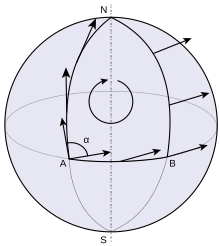Riemannian holonomy
The mathematical term of the Riemann holonomy group or Riemann holonomy describes the group of linear transformations in differential geometry that is induced by the parallel transport of vectors along closed curves.
definition
Let be a Riemannian manifold . The Levi-Civita connection defines the parallel transport on . For every closed curve
with the parallel transport defines a linear mapping
- .
As (Riemann) holonomy of one refers to the group of all invertible linear maps
- ,
for which there is a closed curve with . Because of
- and
is actually a group.
Decomposability of holonomy representations
De Rham's decomposition theorem : The holonomy representation of a simply connected Riemannian manifold is reducible if and only if the metric is locally a product. If the manifold is geodetically complete , the metric must even be a product metric globally .
Classification of irreducible holonomy representations
Berger's list : The holonomy group of a simply connected , irreducible, nonsymmetrical Riemannian manifold is one of the following:
- with ( Kähler manifolds )
- with ( Calabi-Yau manifolds )
- with ( hyperkahler manifolds )
- With
- With
- With
Berger's list of possible Holonomiegruppen originally contained even with this possibility was ruled out in 1968 by Alexeevsky.
The holonomy groups of symmetrical spaces had already been classified by Cartan . For a simply connected, irreducible symmetrical space , the holonomy group is isomorphic to .
Special holonomy : A manifold of special holonomy refers to Riemannian manifolds whose holonomy group is a real subgroup of , i.e. cases 2-7 in Berger's list as well as products in which at least one of the factors falls into one of cases 2-7.
literature
- G. de Rham : Sur la réductibilité d'un espace de Riemann , Comm. Math. Helv. 26 (1952), 328-344.
- M. Berger : Sur les groupes d'holonomie homogène des variétés à connexion affine et des variétés riemanniennes , Bull. Soc. Math. France 83: 279-330 (1955).
Web links
- J. Gross: What is ... Riemannian holonomy? , Notices of the AMS 65 (2018), 795-796.



![\ gamma \ colon \ left [0,1 \ right] \ to M](https://wikimedia.org/api/rest_v1/media/math/render/svg/ce25662a6caa6a505c7bd234262407b9a270358b)























